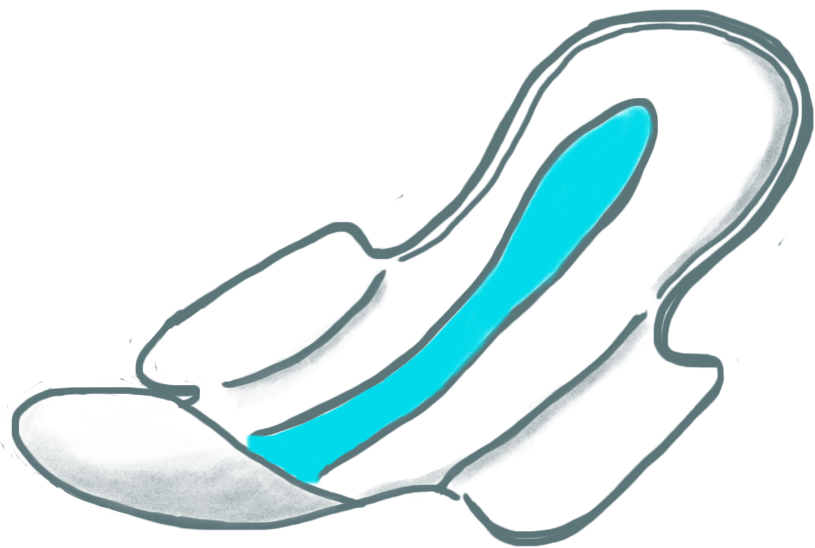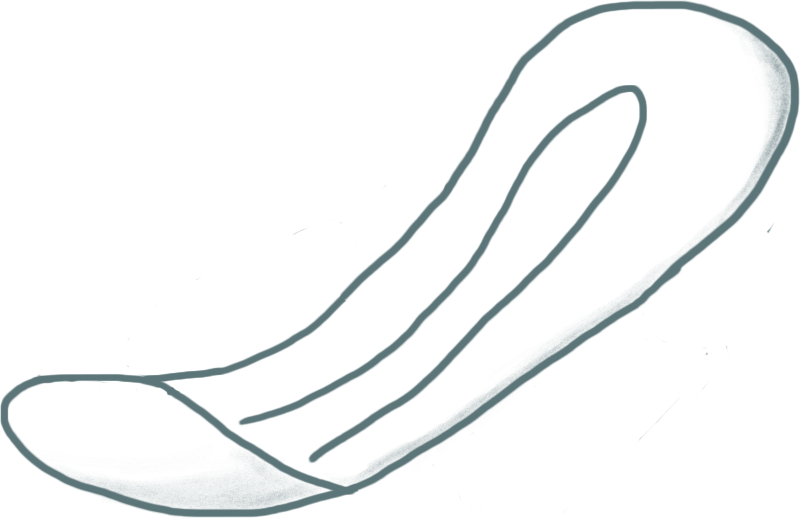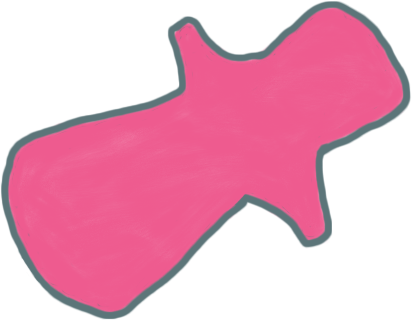
The Gross Factor:
Why American Women Won't Try Reusable Menstrual Pads
It was the summer between 6th and 7th grade when Jaime Olinger first had her period. The then 11-year-old had no clue what to expect or how to handle her menstruation. Olinger’s mother had never talked to her about it.
Unclear of what to do with the blood and discomfort, Olinger took her mother’s menstrual pads without a single question.
“I never asked about pads and she never asked what I needed,” Olinger remembered, describing learning menstruation from her friends but not her own mother.
She said she briefly understood what menstruation meant but never got a clear concept or knowledge. The avoidance of talking about menstruation between Olinger and her mother shied her away from asking questions or even just mentioning about the topic.
“I got the impression growing up that you kept that private and never talk about [menstruation],” she said.
I never felt comfortable talking about my period until I was in college.
— Jaime Olinger

Jaime Olinger (Almond Li/Annenberg Media)
Now 36 and a stay-at-home mom, Olinger knows more about her menstrual cycle – and makes a living by selling handmade reusable menstrual pads on Etsy, an e-commerce platform.
Washable pads that can be reused multiple times. They are usually made with fabrics such as cotton and organic bamboo velour.
The term reusable menstrual pad seems alienated from the major feminine sanitary product market in the United States. Multinational companies such as Procter & Gamble and Kimberly-Clark dominate the U.S. and global markets. Menstrual pads like Always and Tampax tampons by P&G, Kotex and Poise by Kimberly-Clark, Carefree and Stayfree by Johnson & Johnson, can easily be found in supermarkets and drug stores.
A report studying global markets and opportunity of feminine hygiene products by Research and Markets estimates it will garner a revenue of over $42 billion by 2022, but the market of reusable menstrual products remains a niche.
Chris Bobel, president of Society for Menstrual Cycle Research, said it’s hard to tell whether businesses of reusable products will have a market share, but she observed a growth of the sector.
Olinger started using reusable pads for her menstrual cycle three years ago. She had experienced numerous health problems, such as abrasion and allergies, throughout the years from using disposable products. She heard of cloth pads from a friend and decided to try something new. Her symptoms were greatly alleviated after using reusable pads.
“It was life-changing and I never went back,” she said.
After doing research on what is included in disposable pads, Olinger said she was even more repulsed by them. “I didn’t like the idea of all of the chemicals and bleaches and strange fibers being in the most sensitive part of my body.”
Different Materials used in Disposable and Reusable Pads
(Hover over the layers to see what they are made of.)






Illustration: Almond Li
Sources: Always & Jamie Olinger
Top layer:
Polyolefins
• Its low absorbency helps pull fluid away from the skin.
• Polyolefins are commonly used in plastic products and clothes.
Absorbent layer:
Absorbent foam
• Fluid is absorbed and stored in this layer.
Wood cellulose with gel, rayon & polyester
• Rayon is a highly absorbent synthetic fiber.
Bottom layer:
Polyolefins
• Water-proof layer to prevent the fluid from leaking.
Adhesive
• A type of glue to stick the pad on underwear.
Top layer:
Cotton/ Organic bamboo velour/ Swim knit etc.
• Breathable materials are used.
• Its soft surface reduces abrasion.
• First layer to absorb fluid.
Absorbent layer(s):
Heavy organic bamboo fleece & flannel
• Highly absorbent fibers to store fluid.
• Multiple layers may be used for heavy-flow pads.
Bottom layer:
Wind Pro fleece/ Micro-fleece
• Breathable
• Fluid-resistant layer to prevent leakage.
The U.S. Food and Drug Administration said manufacturers of disposable menstrual products are not required to list all the materials used to make the pads or tampons.
A report by Women’s Voices for the Earth quoted case studies conducted on feminine products to show carcinogenic chemicals used in pesticides and fragrance are found in disposable pads and tampons.
“It’s troubling to not knowing what materials are in there when it is a product that many women wear inside their body or on their body for hours, or days at a time,” said Katie Hasson, a USC gender studies professor, who does research on menstruation.
Despite studies showing possible harmful effect of disposable products on women’s health, the acceptability of reusable menstrual products among American women is still low. Olinger said one of the reasons is women are not aware of the alternative menstrual products available in the market.
Olinger said young girls are not well-educated about this very important phase in a woman’s life and are exposed to very limited options when it comes to menstrual products.
“Here is your tampon; here is your disposable plastic sticky pad,” she said. She listed examples of alternatives women could opt for – menstrual cups, sponges, cloth pads and more.
“I so wish that I have known about these years and years earlier. And I wish that young women now would be exposed to these options,” Olinger said.
Olinger said it takes her 15 minutes to finish sewing one pad. (Almond Li/Annenberg Media)
Click here if the video doesn't play.
Inadequate Menstrual Education at Schools
A lot of the time menstruation is not included in sex education at schools. Comprehensive sex education suggested by Sexuality Information and Education Council of the United States focuses on teaching young people about safe sex, sexual-transmitted diseases, but sheds little light on a vital stage of puberty for girls – menstruation.
Hasson said many school districts in the U.S. have strict rules about what kind of sex education is taught. She said education about menstruation provided to young girls by schools is sometimes outsourced to a third party.
She said most of the curriculum of menstruation is designed and provided directly from manufacturers of brands like Tampax or Kotex, and sometimes it comes along with free samples. Girls are taught the ways to handle their periods with a particular kind of product and thus have a narrow perspective.
Leslie Picazo, in her 30s, said she has not heard of reusable menstrual products before. “But I have heard of feminine products before.” She wasn’t sure what reusable products mean.
Even for people who know or hear of reusable menstrual products, their reactions are mostly negative. Noelle Gackle, 21, is one of those voices.
Long-standing Menstrual Stigma
Olinger said the negative public perception towards reusable products roots from the stigma of menstruation.
“They are very grossed out at the idea of having to handle their bodily fluid,” she said, “I wish that people [and] young girls weren’t taught that their period is so disgusting, that is gross. It’s something you have to hide and you have to be ashamed of.”
Alysha Seriani from Lunapads, a Canadian-based cloth pad company that has business in the US, said people have long perceived menstruation as something “unhygienic.” She said it could be observed from how menstrual products are named – feminine hygiene products.
There are a lot of shame and taboos around menstruation in the society, said Hasson. She said despite people are more open to talk about menstruation now, visible signs of blood are still very tabooed.
Hasson said the introduction of disposable menstrual products in the early 20th century and the advertising intensified the cultural pressure on public perception of menstruation has to be concealed.
“If you have the menstrual technology to hide the evidence of menstruation, it also increases the pressure to use them and to hide it,” she said.
The media has contributed to deepening women’s impression about menstruation as something gross and shameful, as Hasson explained, “the focus of disposable menstrual products is just to make it disappear; to not deal with it.”
Hasson said even though commercials for menstrual pads choose to use blue liquid to represent the blood, which does not reflect how menstrual blood truly is. Women are shied away from talking about their periods, not to mention embracing the natural biological process.
Environmental Impacts

Click to enlarge the image.

x
More than 2 billion women in the world are at menstruating age, which is from 12 to 50 years old on average. There are more than 85 million in the US alone. They dump more than 12 billion pads and seven million tampons to the landfills every year.
Plastics and synthetic fibers used in making disposable pads take hundreds of years to decompose. The environment can hardly catch up with the rapid rate of the massive dumping of disposables.
pads and tampons have been thrown away in the time it took to read this story.
Yet, a study by Rochester Institute of Technology shows that American women still prefer disposables even after they gain more understanding of the environmental pollutions and health problems brought by disposables.
The study found that the convenience and the price of getting reusable products are among women’s top concerns when making their purchase decisions. Reusable products are not widely available in regular drug stores or supermarkets. Olinger said they are usually only available online at places such as Etsy and Amazon.
Even bigger companies like Lunapads from Canada and Gladrags, which originates from Portland, Oregon, online sales are a more common form observed. Lunapads said their products are available in Targets stores since September this year. However, not many branches carry the physical product in store; customers still have to order online.
College student Hailey Konovalov said she heard of reusable pads but didn’t know they are actually available.
Accessibility is a big challenge to expand the market of reusable menstrual products. Drug stores or supermarkets are where women go to when they are in urgent need of menstrual products, instead of Etsy or Amazon.
The Rochester study also points out the high initial cost of getting reusable products discourages women from making the switch. A pack of 20 disposable pads costs $7 at Walgreens, but for the same price, a customer can only get one cloth pad at Olinger’s Etsy shop or other similar shops. The price of some other types of cloth pads that handle heavier menstrual flow is double of a pack of disposables.
“It’s deceiving,” Olinger said, “You will pay the investment upfront […] if you consider how many boxes of tampons and pads that you continuously have to buy every month, the initial investment of cloth pads is nothing.” Menstruation can cost a woman thousands of dollars over her menstrual life cycle.
How much are you paying for your period over a lifetime?
How much do you pay for your pads?
I use pads per day
My cycle lasts for days
(Base on the average unit price $0.19 of the top three brands of pads.)
You spend:
$ every menstrual cycle
$ every year
$ a lifetime
How much do you pay for your tampons?
I use tampons per day
My cycle lasts for days
(Base on the average unit prices $0.23 of the top three brands of tampons.)
You spend:
$ every menstrual cycle
$ every year
$ a lifetime
A reusable pad could last 10 years and save 10 years’ worth of money spent on tampons or disposable pads, so women are eventually saving their money in the long run, Olinger said.
Experts and sellers of reusable menstrual products said educating women about their period and alternatives they have are important to break the long-time stigma and negativity around it.
pads and tampons have been thrown away in the time it took to finish this story.